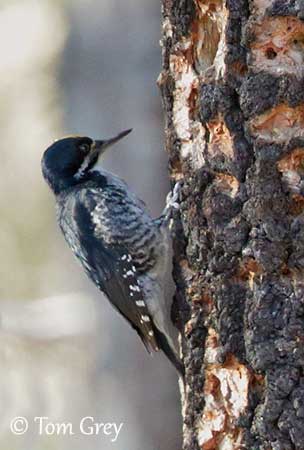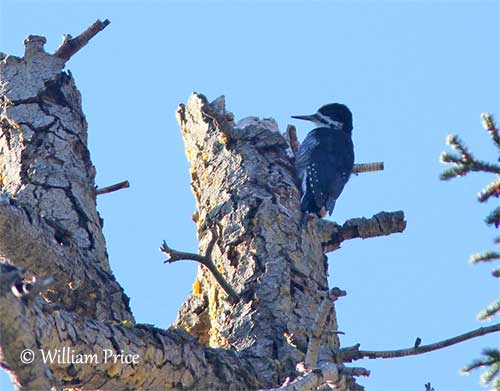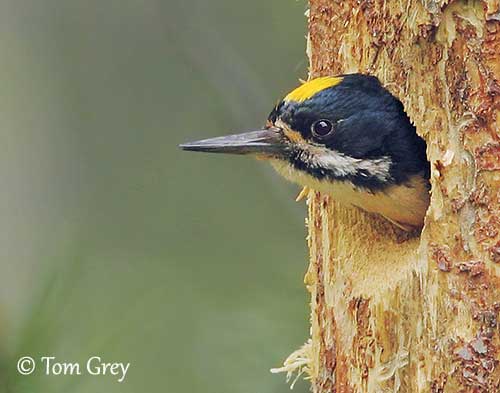
The female lays 3-4 (sometimes 2-6) white eggs. Both adults share the incubation during 12-14 days, the male at night and part of the day. The chicks are fed by both parents. The male usually makes less feeding trips than the female, but it forages farther from the nest and brings more food. The young leave the nest about 21-25 days after hatching. They still depend on parents for food for a few weeks more.
This species produces a single brood per year, but replacement clutch is reported after nest failure.
PROTECTION / THREATS / STATUS:
The Black-backed Woodpecker has large range in which it is described as “uncommon”. However, the species can be common in coniferous forests affected by fire where it can find larvae of wood-boring beetles. The birds usually move large distances to find these suitable habitats.
The population trend is poorly known, but the species may face significant threat of habitat loss from suppression of fires, loss of mature forests and removal of snags by illegal logging.
But the species is not globally threatened, and the Black-backed Woodpecker is currently evaluated as Least Concern.
Fr: Pic à dos noir
Ang: Black-backed Woodpecker
All: Schwarzrückenspecht
Esp: Pico ártico
Ita: Picchio dorsonero
Nd: Zwartrugspecht
Sd: svartryggig hackspett
Photographers:
Tom Grey
Tom Grey's Bird Pictures & Tom Grey's Bird Pictures 2
William Price
PBase-tereksandpiper & Flickr William Price
Text by Nicole Bouglouan
Sources:
HANDBOOK OF THE BIRDS OF THE WORLD Vol. 7 by Josep del Hoyo-Andrew Elliott-Jordi Sargatal – Lynx Edicions – ISBN: 8487334377
Woodpeckers of the World: The Complete Guide by Gerard Gorman – Editeur: A&C Black, 2014 – Helm Photographic Guides - ISBN: 1408147173, 9781408147177
WOODPECKERS, an identification guide of the woodpeckers of the world by Winkler Hans and Christie David – Helm – ISBN: 0395720435
Bird Web (Seattle Audubon Society)
Animal Diversity Web (University of Michigan Museum of Zoology)
South Dakota Birds and Birding – (Terry L. Sohl)
Black-backed woodpecker nest-tree preference in burned forests of the Sierra Nevada, California
What Bird-The ultimate Bird Guide (Mitchell Waite)
Wikipedia, the free encyclopaedia
Black-backed Woodpecker
Picoides arcticus
Piciformes Order – Picidae Family
INTRODUCTION:
The Black-backed Woodpecker is a North American species found from W Alaska to Nova Scotia, a large range in which it is resident.
It frequents boreal and montane forests of North America. The species is generally observed near recently burned forests. It feeds on insect larvae found below the bark of trunks of conifers and dead trees, especially the larvae of wood-boring beetles.
The Black-backed Woodpecker is monogamous. During the courtship displays, the yellow crest feathers play an important role to attract a female. They typically nest in tree cavity excavated by both mates. Both parents share the nesting duties.
The Black-backed Woodpecker is described as “uncommon” but the population is suspected to be stable, and currently, the species is not globally threatened.
DESCRIPTION OF THE BIRD:
Biometrics:
Length: 23-25 cm
Wingspan: 43 cm
Weight: 61-88 g (71 g)
The Black-backed Woodpecker adult male has black head and upperparts. The back is uniformly glossy black. The upperwing is black with narrow white bars on primary and secondary flight-feathers, whereas the wing-coverts are glossy blue. The tail is mostly black with white outer rectrices.
On the underparts, throat, breast and belly are white. Body sides and flanks are white with black barring. The undertail is white.

On the black head, a white stripe extends from lores to below the ear-coverts and to the neck sides. The male shows a bright yellow crest and a fine white line behind the eye.
The slate-grey, straight bill is fairly long and chisel-shaped. The lower mandible is paler with sometimes horn-coloured base. The eyes are brown to red-brown. Legs and feet are dark grey to slaty grey.
This woodpecker has three toes (four toes in most species), with two forwards and only one backwards. This peculiar morphological feature may allow the bird to lean farther back in order to deliver stronger blows to the trunk, and excavate hollows in harder wood.
The adult female is almost similar but her plumage is slightly paler in colour, the bill is shorter and she lacks the yellow crest.
The juvenile is duller and browner than adult. The wings show more white and the pattern of the underparts is less regular and more diffuse. The eyes are paler.
The young male may show some yellow/orange-yellow on crown whereas the young female shows a few small yellow spots or no yellow.
RANGE:
The Black-backed Woodpecker is found from W and C Alaska, E through C Canada to S Labrador and Newfoundland, and S continuously in W to California and W Nevada, Wyoming, SC Saskatchewan and NE Minnesota, and in E to N Michigan, SE Ontario, New York and Nova Scotia.
HABITAT:
The Black-backed Woodpecker inhabits boreal and montane forests with conifers, often firs and spruces. It usually favours recently burned forests, areas of dead or dying conifers, but also burned or flooded areas with numerous standing dead trees. It also frequents undamaged forests of conifers.
It is mainly found in lowlands in the northern range, and in mountains in the west.
The species occurs from sea-level up to 3,000 metres of elevation, depending on the range.

CALLS AND SONGS: SOUNDS BY XENO-CANTO
The Black-backed Woodpecker has very sharp, fast call, a single note “kyik”. This call is used between mates, but also to defend the territory and during chick-feeding.
We can also hear a peculiar, long, grating snarl varying in pitch and described as “wet-et-ddd-eee-yaaa”. This sound may vary from fast series of clicks into fast, rasping snarl.
This call is given during encounters with other woodpeckers, and is usually associated with head-swinging display.
Parents and young communicate with a gurgling call during chick-feeding.
BEHAVIOUR IN THE WILD:
The Black-backed Woodpecker feeds primarily on insects, and especially wood-boring beetle larvae (Monochamus scutellatus) usually found in burned forests, bark-dwelling Scotytids (Pissodes) and larvae of mountain pine beetle (Dendroctonus ponderosae). Other insect species, spiders and centipedes are also part of the diet. It also consumes some fruits and seeds.
The Black-backed Woodpecker forages alone or in pairs. This behaviour consists of peeling the bark of dead trees while searching for prey. It is able to remove the bark of an entire snag! It also gleans insects from bark in live trees.
The bird forages mainly on large-diameter trunks, also on large branches and fallen timber. But it prefers fire-killed trees such as Pinus strobus.
It forages by pecking with blows to remove pieces of bark, and hammering to perform deep excavations. It rarely catches insects in flight and forages mainly on lower sections of trunks.
The Black-backed Woodpecker defends its nesting territory and performs several displays such as “crest-raising” to display the yellow feathers, “hunched-head swinging” displays and wing and tail spreading.
This species is monogamous and both mates remain together year round. They nest in tree-cavity in burned forest.
The courtship displays include flutter-aerial displays and rising of crown feathers.
The Black-backed Woodpecker is resident throughout the range, but it may perform irruptive movements related to recently burned areas allowing the bird to feed and nest.
The flight is typical of Picidae, direct and undulating with powerful wingbeats interspersed with glides.
REPRODUCTION OF THIS SPECIES:
The Black-backed Woodpecker starts to excavate the cavity in late March. Both adults share this work. The height varies from 5 to 11 metres above the ground (sometimes less than 1 metre) in dead tree, but also in live tree or utility pole. The bark is cleared away from the area around the nest entrance.
The laying takes place from mid-May to mid-June, sometimes starting from end April.
